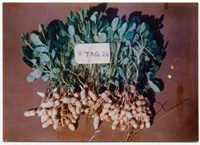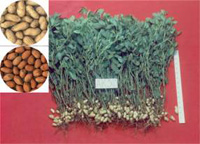Oilseed Research Unit, Akola
About Station

Oilseed Research Unit was established in Dr. Panjabrao Deshmukh Krishi Vidyapeeth Akola in the year 1972, with the inception of AICRP on Sunflower. Sunflower seed production and Groundnut Seed Production centres (AOS-Annual Oilseed Scheme) were established in the year 1974 and 1987 respectively at Akola. Govt. of Maharashtra has sanctioned a scheme on Strengthening of Oilseeds Research Programme (SORP) in the year 1980. Recently in the year 2001, AICRP on Safflower was established at Akola. In this way at present, four ICAR projects are running in Oilseed Research Unit at Akola. This centre is also working voluntarily on groundnut since, 1976.
Administrative set-up
|
Director of Research |
||||
|
Senior Research Scientist (Oilseed) |
||||
|
|
|
|
||
Agro Climatic Information
Akola is situated at an elevation of 307.4 meter above the mean sea level at 220 42’ North latitude and 770 02’ East longitude and has subtropical climate. Normal rainfall of 768.5 mm in 41 rainy days received at Akola centre. Rainfall received during four months i.e. June to Sept. maximum temperature ranges between 29.0 0C to 47.2 0C. April, May and 1st week of June are the hottest period in which temperature ranges between 33 0C to 44 0C. However, in the month of December and January maximum temp is below 30 0C. The minimum temp ranges between 10.3 0 to 27.6 0C. Bright sunshine hours ranges between 3.3 to 8.8 hours. In rainy season sunshine hours are less (3.3 to 4.5 hours) wind speed in the range of 4.9 to 9.1 km/hour during January to April. However, it is more onwards April up to Sept. (10 to 16.2 km/hour). Relative humidity 10 % during summer and maximum in Rainy season i.e. 88 %. Evaporation rate is maximum during summer (17.3 mm/day) and minimum in the month December and January (402 to 5.2 mm day).
Infrastructure
|
Location
|
Area(Ha)
|
|
Shivar Block, CRS
|
5.81
|
|
Shivani Block, CRS
|
4.00
|
|
Total Land
|
9.81
|
Mandate
AICRP on Sunflower
- Evaluation of genetic resources
- To develop region-specific high yielding varieties/hybrids with resistance to biotic and abiotic stresses
- To develop economically viable production and protection technologies to augment the production
- To evaluate the varieties/hybrids and technologies of national and regional importance through multi-location testing
- To provide the base for exchange of scientific information, inter-institutional and inter-disciplinary linkages between the national institutes and state agricultural universities
- Transfer of technologies
SORP Safflower
-
To develop high yielding varieties with high seed oil content (35-38%) and inbuilt tolerance /resistance to major insect pests (aphids) and diseases (Alterneria leaf blight, wilt and root rot) for irrigated and rainfed areas in traditional safflower belt
- Evolve early maturing and non spiny varieties with desirable agronomic features (insect pest and disease resistance, high seed oil content, etc.) suited to different non-traditional areas and situations
- Exploit hybrid vigour using the available male sterility systems, perfection of seed production technologies and exploration of CMS systems
- Develop appropriate agronomic practice for maximizing the productivity potential of safflower in sole, relay/sequential and intercropping systems in rainfed as well as irrigated areas on system approach
- Identify productive and profitable inter and sequential cropping systems for all potential areas of safflower cultivation.
- Accelerate the tempo of on-farm researches for bridging the gap between reliable and actual yield and axploit the untapped yield reservoirs
- Undertake basic and breeder seed production of commercial varieties and refinement of seed production agronomy
- Augment, coserve, evaluate and document genetic resources
-
Develop integrated pest and disease management
Groundnut :
- Evaluation of genetic resources.
- To develop region-specific high yielding and high oil quality varieties with resistance to biotic and abiotic stresses.
- To develop economically viable production and protection technologies to augment the production.
- To evaluate the varieties and technologies of national and regional importance through multi-location testing.
- To provide base for exchange of scientific information, inter-institutional and inter-disciplinary linkages between the national institutes and state agricultural universities.
- Transfer of technologies.
Seed Production
- Nucleus and breeder seed production of improved varieties / parents of hybrids of sunflower, safflower and groundnut.
Objectives
-
Development and testing the varieties and advanced breeding lines in oilseed crops (sunflower, safflower and groundnut) for its suitability and specific adaptability in the region of Vidarbha.
- To identify and develop the varieties of predominant oilseed crops of the region with resistance to pests, diseases, earliness and draught tolerance.
Research Activities and Achievements
Dr. Panjabrao Deshmukh Krishi Vidyapeeth has developed 7 varieties in groundnut, 5 varieties in sunflower and 2 varieties in safflower based on the needs of cultivators of this region. Also, identified 13 varieties in these three crops. In addition, 102 recommendations have been given on crop production and crop protection.
Improve oilseeds crop productivity for better monetary return by developing suitable cropping systems under given farming situation
|
Groundnut Varieties Developed and Released by University
|
|||
|
Year : 1984 …. UF 70103 (VB)
|
Year:1992 …TAG–24 (SB)*@
 |
Year :1996 ….. TG–26 (SB) | |
|
|
 |
||
|
Year : 2002… AK-159 (SB)
 |
Year: 2007…AK-265 (VB) FDR |
Year:2009 …AK-303 (VB)HPS |
|
| Sunflower Varieties Developed and Released by University | |||
|
Year : 1983 …. Surya
|
Year : 1996 …. PKVSH-27 (Hybrid)
 |
Year : 1996 … PKVSF–9
 |
|
|
Year : 2007 … TAS–82*
 |
|||
| Safflower Varieties Developed and Released by University | |||
|
Year : 2007 …AKS-207
 |
|
Year : … PKV PINK |
|
|
Other varieties identified by university
|
|||
|
Groundnut
|
AK-12-24, SB – 11@, JL – 24@, ICGS – 11, Girnar–1, TKG – 19A | ||
| Sunflower | EC–68414, Morden, KBSH–1 (Hybrid) | ||
| Safflower | N-7, Bhima @, NARI-6 (Non-spiny) | ||
| * Developed and released in collaboration with BARC @ Most popular variety | |||
Research Recommendations (Approved in AGRESCO)
Recommendations for Groundnut Production Technology
- Early sowing (10th to 15th June) of kharif groundnut with one or two irrigations is found beneficial than normal sowing (25th to 30th June) on the onset of the monsoon.
- Spacing at 30 cm to 45 cm between rows and 10 cm to 15 cm between plants according to variety should be followed for higher yield.
- Basal application of 25:50:0 kg NPK/ha is optimum for higher groundnut yields.
- Application of 300 – 500 kg Gypsum/ha at 50% flowering increases the yield in groundnut
- Supplying P2 O5 through single super phosphate is more beneficial.
- Seed rate should be adjusted according to variety and seed weight.
- Rhizobium seed treatment in groundnut increases the yield by 7%.
- Application at 10 kg Zinc Sulphate along with recommended dose of fertilizers at sowing time increases groundnut yield.
- Last week of January to 1st week at February is optimum time of sowing summer groundnut, last week September to 1st week at October is optimum time of sowing of rabi groundnut.
- Pre-monsoon sowing of groundnut with one or two irrigation increases seed yield
- Under shallow soils, application of Borax @ 5 kg/ha along with recommended fertilizer dose at sowing time and two foliar sprays of Borax (1g/lit of water) at 35 & 50 days after sowing increases the yield of groundnut by 25%.
- Two foliar sprays of NAA @ 10mg/lit of water should be sprayed at 30 and 45 days after sowing for higher groundnut yields.
- Spacing of 30X10cm with 3.33 lakh plant population per hectare is recommended for variety TAG-24. Plant population can be increased up to 4.44 lakh in TAG 24
- Four row method of BBF cultivation increases groundnut yield than that of flat bed (normal) method by about 43 per cent.
- Kharif groundnut should be given one to three protective irrigations during dry spell. Irrigations be given at an interval of 12 to 15 days and 12-15 days after last rain.
- Summer groundnut should be irrigated 15 to 17 times depending upon soil type. Irrigation interval should be 10-12 days in Feb., 8-10 days in March, 6-8 days in April and 4-6 days in May.
- Immediately after ensuring complete emergence of groundnut, irrigation should be withhold in seedling stage upto 15 to 25 days depending upon soil type to get about 17 to 22% more yield.
- Groundnut kernel sowing practice is superior to dry or water soaked pod sowing.
- By adopting all improved package of practices groundnut gave 44% higher seed yield and 15% higher fodder yield that normal cultivation practices.
- Irrigation by sprinkler system to summer groundnut gave higher yield and monetary return and 24% water saving as compare to Broad Base System.
- Application of vermicompost 1.25 t/ha + Neem cake 500 kg/ha or FYM 5 t/ha + Neem cake 500 kg/ha with seed inoculation of biofertilizers (Rhizobium + PSB 250 g each/10 kg of seed) is recommended for organically grown groundnut.
Recommendations for Groundnut Protection
Plant Pathology
- Groundnut Seed should be treated before sowing with Thirum + Bavistin 2:1 or Thirum/Captan 2.5 to 3 g/kg. of seed to avoid seed & soil borne diseases.
- Rust on groundnut can be controlled by spraying the crop with any one of the fungicides viz., Plantavax or Vitavax 10 g or Dithare M–45, 25 g or Kalaxin 7 ml. per 10 litres of water.
- Cercospora leaf spot (Tikka) disease of groundnut can be controlled by spraying wettable sulphur 0.3% or Dithane M–45 0.25% or Bavistin 0.1% or by dusting 300 mesh Sulphur dust 20 kg/ha during morning or evening hours.
- For controlling Bud Necrosis disease in groundnut, spraying of Carbendazim 0.1% (1gm in 1lit of water) or Dithane-M 45, 0.2% (2.5gm in 1 lit of water)+Dimethoate 0.03% (1ml in 1lit of water) is recommended.
Entomology
- Aphids, Jassids & Thrips of groundnut can be controlled by spraying Carbaryl 0.2%, Phosphamidon 0.02%, Quinalphos 0.05%, Malathion 0.1%, Phosalone 0.05% or Dimethoate 0.03 %.
- For the control of leaf miner, spraying of Cypermethrin 0.01%, Permethrin 0.01%, Decamethrin 0.0025% or Phosphamidon 0.02% are found effective.
- In case of heavy incidence of Leaf folder if control measure is not possible spraying of any one of the pyrethroid e.g. Cypermethrin 25EC (4ml) or Fenvalerate 20EC (5ml) or Deltamethrin 2.8 EC (10ml) in 10 litre of water is recommended.
Recommendations for Sunflower production Technology
- Sunflower has proved a suitable crop in contingent conditions.
- Sunflower should be sown in 1st week of July, first fortnight of October and last week of January to 1st week of February during kharif, rabi and summer seasons respectively for obtaining higher yields.
- Intercropping of groundnut and sunflower in 6:2 and sunflower and red gram in 3:3 row proportion is found remunerative.
- Growing sunflower after sunflower should be avoided as it increases pest and disease complex and depletes the soil resulting in low yields.
- Spacing at 45 x 22.5 cm with one lakh plant population per hectare for variety Morden and 45 x 30 cm with seventy five thousand plant population for hybrid variety should be followed in Sunflower for higher yields.
- A dose of 40:40:0 kg NPK/ha for Morden and 60:60:0 kg NPK/ha for remaining varieties/hybrids of sunflower should be applied for optimum yields. Potash @ 40 kg/ha should be applied in deficit soils. Nitrogen should be applied in two equal splits at sowing and 35 days after sowing.
- Application of 60 kg phosphorus/ha through Single Super Phosphate at sowing time increases seed and oil yield in sunflower.
- Minimum four irrigations, each at seedling, bud, flowering & grain filling stages during rabi, are required for getting higher yields in sunflower.
- Seed soaking treatments in one litre water, 10mg IAA and 10mg NAA for 6 hrs and then drying under shed gives higher yield of sunflower
- Application of 30 kg N and 30 kg P205/ha at sowing and three foliar sprays at 30, 40 and 50 days after sowing with Diammonium Phosphate + Urea (15 g Urea + 5 g DAP in one litre of water) increases the sunflower yield and reduces the cost on account of top dressing of fertilizers.
- For getting higher seed yield in sunflower, application of 5 t FYM (organic matter)/ha and inorganic fertilizer (40:60:40)NPK kg/ha along with 25kg sulphur/ha and sowing of seed after seed soaking treatment for over night is recommended.
- Spraying of 0.2% Borax (2g Borax +1lit water) at flowering initiation stage only on capitulum and recommended dose of 5t FYM/ha and 60:90:60 NPK kg/ha gave higher yield of sunflower hybrid PKVSH-27 in seed production programme.
- Sunflower stalk cutting with application of cellulatic microorganism culture alongwith dung slurry treatment application to the soil, 10 days before sowing of gram during rabi, has not observed any adverse effect on crop and increases Organic Carbon in the soil.
- For seed production of hybrid sunflower PKVSH-27 male female lines should be sown at the same day and application of 80 kg nitrogen, 120 kg Phosphorus and 60 kg Potash is recommended for getting higher yield.
- In sunflower hybrid seed production female and male lines should be sown in 3:1 row proportion with supplemented hand pollination increases 52% seed yield.
- Seed setting of sunflower increased by 30% if at flowering hand pollination practice is followed in morning hours.
- Sunflower crop requires 9-10 irrigations during summer at an interval of 10-12 days in Feb., 8-10 days in March, 6-8 days in April & 4-6 days in May depending upon soil type.
- Application of fertilizer and thinning are most important amongst improved package of practices in Sunflower
Recommendations for Plant Protection of Sunflower
Plant pathology
- Foliar diseases of sunflower caused by Alternaria, Curvularia and Bacterial leaf spot should be controlled by spraying Dithane M-45 0.25% three times at an interval of 15 days, starting first spray from the appearance of any leaf spot disease.
- Fungicidal seed dressing of Brassicol, Captan, Thirum or Bavistin @ 2 to 3 g/kg of sunflower seed was found to improve germination, plant stand and yields by protecting crop from seed and soil borne diseases.
- For controlling sunflower necrosis disease it is recommended that seed treatment with imidacloprid 5g/kg of seed before sowing and two spraying with imidacloprid 0.05% (5.0 ml in 10 litre of water) at 30 DAS and 45 DAS in crop growth period.
Entomology
- It is decided that Economic threshold Level for Leaf hopper on Sunflower is 3 nymphs/leaf.
- Use of nitrogenous fertilizers should be as per the recommended dose to reduce incidence of leaf hopper.
- For the management of mealy bug on sunflower spraying of dichlorovos 76% WSC @ 20 ml or methomyl 40 SP @ 10g + 20 g soap powder in 10 liter of water as soon as the pest incidence occurs and if needed second spraying is recommended.
- For management of whitefly and thrips on sunflower treatment with imidacloprid 70 WS @ 5 g/kg seed OR two spraying of Azadirachtin 1500 ppm @ 20 ml / 10 lit. of water at 15 and 30 days after emergence is recommended.
Recommendations for Safflower production Technology
- Optimum sowing time for safflower under rainfed is last week of September to first week of October for higher yields and minimising attack of aphids. Under irrigated condition, sowing can be extended upto last week of October.
- A spacing at 45 x 20 cm to 30 cm with plant population ranging from seventy five thousand to one lakh gives higher yields in safflower.
- For higher yield of irrigated safflower 40 kg N+40kg P2O5/ha is recommended. 50% N and 100% P2O5 at the time of sowing and remaining 50% N after 30 days of the sowing have to be given.
- Three to five irrigations should be given to safflower in medium to lighter type of soils for higher yields.
- Safflower should be irrigated twice i.e. at 35 and 55 days after sowing in medium to heavy soils for higher yields. If only one irrigation is available, it should be given at 55 days after sowing.
- Intercropping of safflower with gram or linseed in 6:3 or 3:3 row proportion (30cm) and two rows of safflower paired (30/60 cm) plus one row of gram or linseed is profitable.
- In favourable conditions, application of fertilizer @ 25:25:0 NPK kg/ha is recommended.
- To save 25% P2O5 (18.75kg/ P2O5/ha) it is recommended to treat seed with PSB @ 200 g/10kg seed
- For getting higher seed yield and monetory return seed of safflower should be treated with Azotobactor and Azospirilum 20 g/kg seed along with 12.5 kg N/ha are recommended.
- In Vidarbha region (Akola) of Maharashtra, application of cycocel @ 500 ppm either at flower initiation or at 50% flowering could increase the seed yield of safflower by 15 % under moisture stress conditions.
- In Vidarbha region (Akola) of Maharashtra , apply 30 kg S/ha through single super phosphate to increase seed yield and returns of safflower under rainfed conditions.
- In Vertisols (Deep black soil), for maximum yield and highest monitory return in irrigated condition, sowing of safflower during 40th MW (1st week of October) or as late as 44th MW (1st week of November) is recommended. Also, two irrigations, first during vegetative stage (30 DAS) and second at grain development stage (80 DAS) is recommended.
Plant protection of safflower
Plant pathology
- For controlling Alternaria Leaf Spot, seed treatment with Thirum or Captan 3g/kg seed is rcommended and in field condition spraying with Dithane M-45, 25g in 10 litre of water is recommended.
- For controlling root rot and wilt, seed treatment with thirum or captan @ 3g/kg seed alongwith seed treatment of biological fungicide Tricoderma 4g/kg seed is recommended.
Entomology
- Early sowing (i.e. during 25th September to 10th October) of safflower is recommended to escape from aphid infestation.
- It is recommended to adopt plant protection measures against safflower aphid when economic threshold level of aphid colonies on 30% plants is reached.
- For management of safflower aphids spraying of Fenthion 50 EC (10ml) or Quinalphos 25 EC (20ml) or Thiometon 25 EC (12ml), or Dimethoate 30 EC (10ml), or Acephate 75% WSP 4gm or Malathion 50 EC (20ml) or Carbaryl 50% WSP 20g in 10 lit of water or dusting of Quinalphos 1.5 % dust or Methyl Parathion 2% dust or Phosalone 4 % dust @ 20kg/ha is recommended.
- For effective management of Gujhia weevil, application of Phorate 10 G @ 10 Kg/ha at sowing + foliar spray of chlorphriphos 20 EC @ 25 ml OR Lymbda chalothrin 2.5 EC @ 10 ml/10 ltr of water at 10 days after emergence and need based second spraying at 10 days after first application is recommended.
Transfer of Technologies
- Conducted large scale front line demonstrations (FLD) of Sunflower, Safflower and Groundnut and successfully transferred technologies developed by this research unit in terms of varieties and their cultivation practices.
Publications
- Booklet: Telbia Pike Sudharit Lagwad Tantra. (80 pages)
Contact Information
Senior Research Scientist (Oilseeds)
Oilseeds Research UnitOilseeds)
Dr. PDKV, Akola.-444104 (M. S.)
Phone (O): 0724 2258467
Mobile :+91-8275286910
E-mail : srsoilseedspdkv@rediffmail.com






 Krishikosh Repository
Krishikosh Repository





